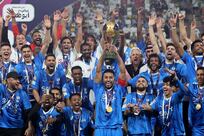Vincent O'Brien, who has died aged 92, is widely regarded as the greatest horse trainer of all time. He began as a trainer of steeplechasers, winning an unprecedented three consecutive Grand Nationals with three different horses - Early Mist in 1953, Royal Tan in 1954 and Quare Times in 1955. Over three successive years, he won the Champion Hurdle with Hatton's Grace (1949-51), and the Cheltenham Gold Cup three times in succession with Cottage Rake (1948-1950).
In the 1950s he moved to Flat racing, winning the Derby six times. For those who witnessed it, the 1970 triumph of the O'Brien-trained Nijinsky - named after the extraordinary Russian dancer of the 20th century - was an intoxicating and unforgettable event. None except a select few knew that the horse had been at death's door a matter of hours earlier. For more than 50 years O'Brien was the leader of racing, accorded the title of best jump trainer and best flat trainer by the Racing Post, the sport's trade newspaper, before handing in his licence in 1994. As he retired, Dubai's Al Maktoum brothers were posing a serious challenge, with their Godolphin Stables providing many of the pre-eminent horses on the track.
O'Brien's legacy includes the Coolmore Stud in County Tipperary, an international breeding operation that he cofounded with his son-in-law, the trainer John Magnier, and the businessman Robert Sangster. A multimillion-pound enterprise, it is responsible for many of the thoroughbred stallions that have triumphed at Group One. At Coolmore, he introduced the bloodline of a Canadian-bred horse called Northern Dancer, who had won the Kentucky Derby. Nijinsky, probably the greatest of O'Brien's horses was a son. He also established a sister facility at the Ballydoyle training grounds in Tipperary where the primary gallop was modelled on the undulations of Epsom Downs (where the Derby is run), giving the horses bred at Coolmore a key advantage in their training.
Originally O'Brien had thought to become a butcher. Born in 1917 into a farming family in Ireland's County Cork, he left school aged 15. His father was a small-time trainer: on his death, his firstborn son took over the farm. O'Brien, the second son, soon conformed to type, enjoying his first win on the horses in 1944 in the Irish Autumn Double with his two first purchases, Drybob and Good Days. Gambling on horses was a way of life in the locality. Even the local priest was known to enjoy a flutter or two. In the early years, O'Brien was as canny a gambler as he was a trainer, amassing enough money to purchase good stock. Later, a combination of luck, sheer hard work, business acumen and a fundamental affinity for horses brought him to the pinnacle of the horse racing world.
The Irish authorities withdrew his licence twice; the first time for the inconsistent running of four jumpers in 1954, the second in 1960, when his horse Chamour failed a dope test. After the latter incident, O'Brien and his family left Ballydoyle for a year. He returned in 1961 and the following year won his first Derby with Larkspur, owned by Raymond Guest, the American ambassador to Ireland. O'Brien's next Derby win - with another Guest-owned horse, Sir Ivor - in 1968 marked the start of a long and sometimes troubled association with the jockey Lester Piggott, who rode for O'Brien at the Ballydoyle stables for most of the 1960s and 70s.
After retirement, O'Brien wintered in Perth with his Australian-born wife Jacqueline, who co-wrote his biography. Vincent O'Brien was born on April 9, 1917. He died on June 1. He is survived by his wife and five children. * The National





